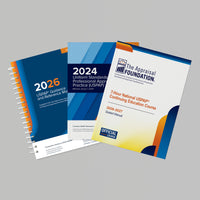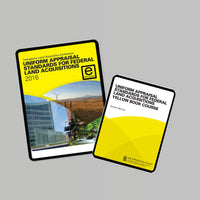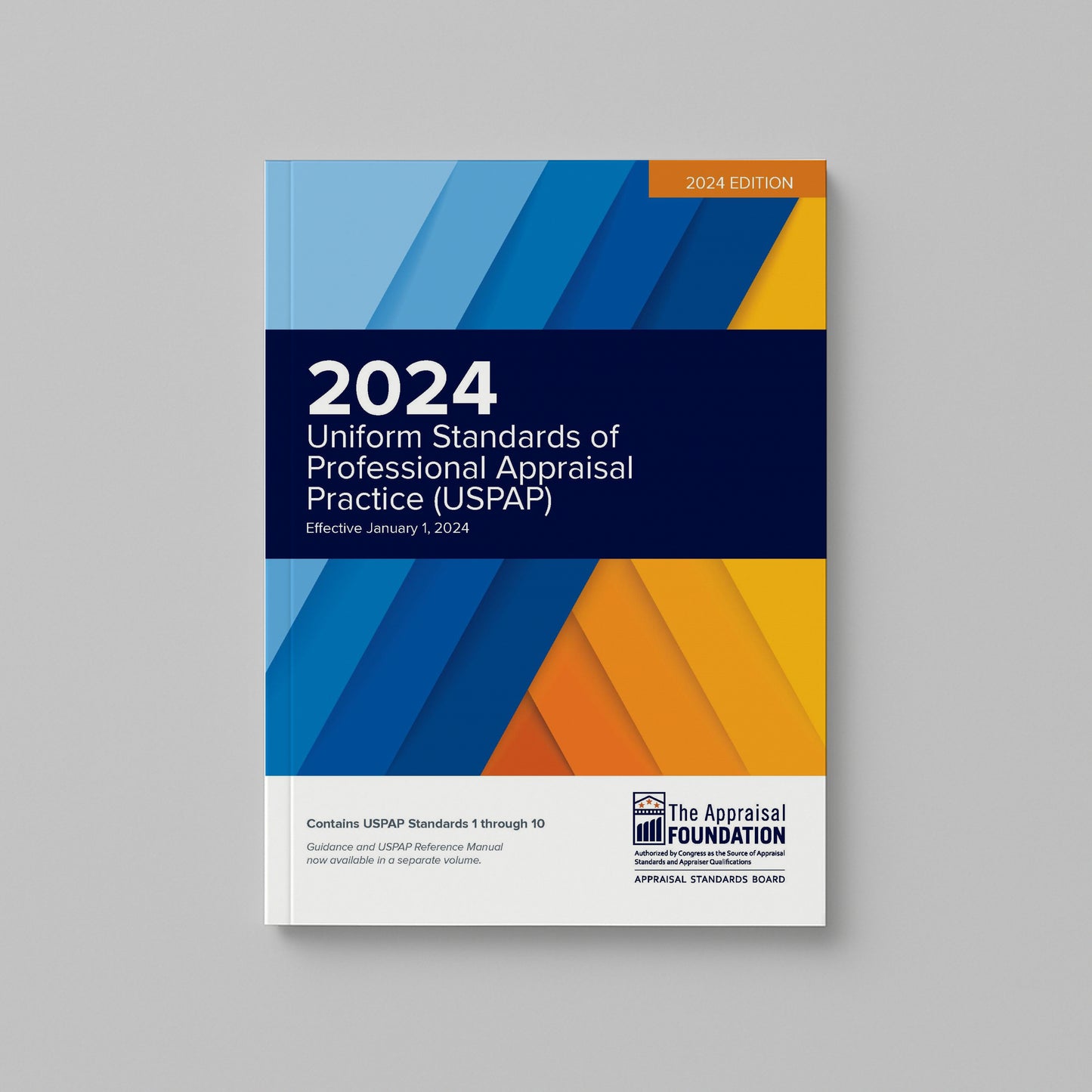Q: My state requires appraisers to be credentialed and to comply with USPAP®. The scope of practice for a Certified Residential credential is limited to residential one-to-four-unit properties. Many residential properties in my state have recently been upzoned beyond four units. Does USPAP® allow any appraiser who holds a Certified Residential credential to complete an appraisal assignment for these upzoned properties?
A: USPAP® does not address issues regarding the scope of practice as restricted by your state-issued credential. If an appraiser is limited in scope of practice as a matter of law or regulation, he or she must comply with that requirement under the COMPETENCY RULE which requires recognition of, and compliance with, laws and regulations that apply to the appraiser or the assignment.
Practicing Appraisers
Explore Q&As, valuation advisories, courses, and additional resources for all appraisal professions.
Overview
Practicing appraisers can use this page to access valuable resources that support their professional development and Uniform Standards of Professional Appraisal Practice (USPAP®) compliance, including Q&As on appraisal standards and qualifications, valuation advisories on industry trends, and tools for personal property and business valuation.
Additional resources can be found in the Resources Center, such as white papers and a full list of approved education courses.
Board-Issued Questions & Answers
Q&As are developed by both the Appraiser Qualifications Board (AQB) and Appraisal Standards Board (ASB) to help answer questions that may not be covered within the Appraisal Foundation®'s (Foundation) currently published materials. These are updated on an as-needed basis, and new Q&As will always be posted on this page.
Upzoning and Questions Related to Appraiser Qualifications Q&As
In a joint collaboration, the ASB and the AQB have each offered their insights on upzoning and appraiser qualifications from their unique expertise.
Q: My state requires appraisers to be credentialed and to comply with USPAP®. The scope of practice for a Certified Residential credential is limited to residential one-to-four-unit properties. Many residential properties in my state have recently been upzoned beyond four units. Does USPAP® allow any appraiser who holds a Certified Residential credential to complete an appraisal assignment for these upzoned properties?
A: USPAP® does not address issues regarding the scope of practice as
restricted by your state-issued credential. If an appraiser is limited in scope of practice as a matter of law or regulation, he or she must comply with that requirement under the COMPETENCY RULE which requires recognition of, and compliance with, laws and regulations that apply to the appraiser or the assignment.
Q: I am currently appraising properties in an area that has undergone rezoning. Previously, the zoning allowed for the construction of between one and four residential units on the lots. However, the new zoning permits up to six residential units to be built on these properties. As a Certified Residential Appraiser, does my credential allow me to appraise these rezoned properties?
A: The AQB does not define your scope of practice. Individuals should reference agency regulations and state laws to determine the scope of practice for Certified Residential (or Licensed) appraisers and the types of properties that may be the Criteria states the minimum qualifications for credential holders and the types of properties they are qualified to appraise. However, it's essential to note that the Federal Financial Institutions Regulatory Agencies, along with other agencies and
regulatory bodies, extend the authority of the Certified Residential (or Licensed) classification to appraise properties beyond those specified within these Criteria.
Q&As from the Appraisal Standards Board
How USPAP Q&As Are Issued and Maintained
The Appraisal Standards Board (ASB) periodically issues USPAP Q&As to provide guidance on applying USPAP in specific situations. These Q&As are published on The Appraisal Foundation’s website and serve as advisory material, not enforceable standards.
Over time, some Q&As are incorporated into the USPAP Guidance and Reference Manual (GRM) as Frequently Asked Questions (FAQs). The ASB regularly reviews Q&As to determine which should be elevated to FAQs and which are no longer relevant.
When a Q&A is retired, it will be labeled “Retired” for a set period before removal. A record of retired Q&As will be maintained for reference.
View and download all active Appraisal Standards Board-Issued Q&As.
Q: I recently completed an appraisal for mortgage financing purposes of real property and delivered the report to my client. My client asked if I could provide a new report and change the borrower’s name. Can I do this and comply with the requirements of USPAP?
A: In many cases, yes, but it depends on the circumstances.
USPAP does not define or require the appraiser to identify the borrower as part of the assignment. Under the SCOPE OF WORK RULE, the borrower’s identity is not a required assignment element. Similarly, Standards Rule 2-2 does not require the borrower’s name to be included in the report.
In most mortgage financing assignments, the borrower is not typically the client or an intended user. If the borrower’s name is included in the report, it is likely because the client requested it. This makes the borrower’s name being included in the report a client condition, not an assignment condition. When it is a client condition, revising the name has no impact on the appraiser’s ability to identify the problem to be solved or to develop credible assignment results, and therefore does not alter the scope of work.
When the inclusion of the borrower’s name does not alter the scope of work, the appraiser may provide a new report with the updated borrower’s name, as long as:
• the change does not make the report misleading, and
• the new report includes the new report date, reflecting the date the updated report is delivered to the client.
If the assignment involves a purchase transaction, a request to revise the borrower’s name may indicate that the purchase agreement has changed. For circumstances where the purchase agreement has been revised after the report was delivered, please refer to FAQ 149 (titled Revision to the Contract Price) in the 2024 USPAP Guidance and Reference Manual for further guidance*.
*This FAQ will appear as FAQ 151 in the 2026 USPAP Guidance and Reference Manual, effective January 1, 2026.
Download
Q: If an appraiser is competent to perform a specific assignment, and has extensive experience in that type of assignment, can they support an adjustment for a property's proximity to a park solely based on that experience?
A: No, experience cannot be a recognized method or technique or a substitute for relevant evidence and logic. Adjustments are a type of assignment result and must meet USPAP®’s requirements for credible assignment results. Assignment results are defined as:
ASSIGNMENT RESULTS: An appraiser’s opinions or conclusions, not limited to value, that were developed when performing an appraisal assignment.
Additionally, credible, is defined as:
CREDIBLE: worthy of belief.
Credible assignment results require support, by relevant evidence and logic, to the degree necessary for the intended use.
This means that adjustments, which are assignment results, must be supported by relevant evidence and logic to the degree necessary for the intended use. Adjustments based solely on subjective judgment, even by an experienced appraiser, fail to meet this standard. The USPAP® definition of an appraiser emphasizes the necessity of objectivity:
APPRAISER: one who is expected to perform valuation services competently and in a manner that is independent, impartial, and objective.
Objective opinions are grounded in what exists and what is known, rather than personal views or preconceived notions.
General knowledge and experience gained from outside of an assignment, which can be valuable in informing an appraiser’s overall competency to perform this specific assignment, is a “personal view” rather than “evidence and logic”.
Competency ensures that the appraiser can identify the problem, determine the appropriate scope of work, and develop credible assignment results, but experience is not a method or technique.
Therefore, for assignment results to be credible they must be objective and developed when performing the assignment. Assignment results cannot be developed from an appraiser’s knowledge and experience which was gained outside of the assignment.
Download
Q: My client has requested an appraisal assignment that would be used in connection with the acquisition of the property by a federal government agency. In addition to complying with USPAP®, I believe the Uniform Appraisal Standards for Federal Land Acquisitions (UASFLA or “Yellow Book”) may have requirements I will need to follow.
My client has not identified any requirements in addition to USPAP® I must follow. If I agree to perform the new assignment, am I required to comply with federal laws, regulations, and follow Yellow Book standards when the client does not specifically make that request?
A: USPAP® requires an appraiser to have knowledge of and comply with all federal, state, or local laws and regulations that are applicable to the assignment as a matter of competency. This means the appraiser must identify assignment conditions.
Assignment conditions are addressed in the Problem Identification section of the SCOPE OF WORK RULE. The RULE states in part:
“Assignment conditions include assumptions, extraordinary assumptions, hypothetical conditions, laws and regulations, jurisdictional exceptions, and other conditions that affect the scope of work. Laws include constitutions, legislative and court-made law, administrative rules, and ordinances. Regulations include rules or orders, having legal force, issued by an administrative agency.”
Assignments used in connection with federal acquisitions may be required to follow the Uniform Relocation Assistance and Real Property Acquisition Policies Act (1970), which is a federal law, and the Yellow Book, which identifies guidance and requirements created by certain federal and court made laws.
If the appraiser identifies that certain federal, state, or local laws or the Yellow Book standards are applicable to the assignment or to the appraiser, the appraiser must follow those standards, whether identified by the client or not.
Download
Q: Am I required to use the term “personal inspection” in my appraisal report?
A: No. USPAP® does not require use of the specific term “personal inspection”.
The term “personal inspection” is only used in USPAP® in the certification requirements. For example, Standards Rule 2-3(a) states:
“I have/have not made a personal inspection of the property that is the subject of this report.”
The wording of a certification for each appraisal report does not have to match the exact wording of the applicable reporting standard (i.e., Standards Rules 2-3, 4-3, 6-3, 8-3 or 10-3) verbatim. The reporting standards only require that, at a minimum, each element addressed in the report’s signed certification must be the same elements noted in the applicable reporting standard (i.e., Standards Rule 2-4, 4-3, 6-3, 8-3 or 10-3).
Regarding a “personal inspection” (or the lack thereof), the appraiser can use different words to address this certification element; however, at a minimum, the USPAP® meaning of the term “personal inspection” must be addressed. For example, when addressing the “personal inspection” certification element in Standards Rule 2-3(a), any of the statements below may be appropriate:
1. I have made a personal inspection of the property that is the subject of this report.
2. I inspected, on-site and as part of the scope of work performed for this assignment, the interior and exterior of the property that is the subject of this report.
3. I have, as part of the scope of work performed for this assignment, inspected in-person from the street, the exterior of the property that is the subject of this report.
4. I did not conduct a personal inspection of the subject property as part of the scope of work of this assignment. I have, however, previously inspected the interior and exterior for a prior appraisal assignment, of the subject property on (date).
5. I did not conduct a personal inspection of the subject property as part of the scope of work of this assignment. I have, however, previously inspected the interior and exterior of the subject property on (date).
6. The appraiser performed a complete visual inspection of the interior and exterior areas of the subject property. The appraiser’s complete visual inspection was conducted onsite and in person as part of the scope of work of this assignment.
7. The appraiser has made a physical inspection of the property appraised and that the property owner, or [their] designated representative, was given the opportunity to accompany the appraiser on the property inspection.
Q: I recently completed an appraisal which included a personal inspection. Soon after I completed that assignment, I agreed to perform a new appraisal assignment on that same property, with the same effective date of value. My new client believes the inspection I did for the prior assignment provided sufficient information about the property to complete a new assignment. I agree that as part of the scope of work for my new assignment I do not need to perform a personal inspection to develop credible assignment results.
For the new assignment, can I use the information I have already collected about the subject property?
A: As with any assignment, you might be able to use information and analyses developed for a previous assignment. Appraisers are often selected for subsequent assignments specifically because of experience and demonstrated competency in a prior assignment. However, one must be mindful of obligations relating to the use of confidential information.
Q: For the new assignment, can I certify I made a personal inspection?
A: No. If the appraiser has certified they made a personal inspection, under USPAP® they are indicating they completed: “... an in-person observation of the subject property as part of the scope of work for the assignment”, which would not be true in this instance.
Q: My assignment from the new client requires my report to include a certification indicating I had “inspected the property as of the effective date of value”, and I am not allowed to modify or change the certification in any way. Since I did inspect the property as of the effective date of value, would this meet the requirement for addressing the USPAP® certification element about “personal inspection”?
A: No. Given the assignment required the use of a certification that could not be altered, and the certification did not clearly and accurately address the USPAP® certification elements about “personal inspection” it would be necessary to use a supplemental certification.
Standards Rule 2-3(d) states: When an assignment requires the use of a certification that does not include all of the certification elements in this Standards Rule, the appraisal report must contain a supplemental certification, which includes the remaining required certification elements.
Q: The certification in my appraisal report satisfies the requirement to disclose if I have (or have not) made a personal inspection. Specifically, my certification states:
I inspected the interior and exterior of the subject property as part of the scope of work performed for this assignment. Am I required to make an additional disclosure in my appraisal report related to my personal inspection?
A: There is no requirement for every appraisal report to include an additional disclosure; however, for some appraisal assignments, it may be necessary for you to include more details about your personal inspection in the report.
For example, the comment to Standards Rule 2-2(a)(viii) states:
Summarizing the scope of work includes disclosure of research and analyses performed and might also include disclosure of research and analyses not performed. Therefore, when necessary, the appraisal report must include a more detailed disclosure about the personal inspection. This is to ensure that any intended user of the appraisal report is not misled about the scope of work performed (or not performed) as it relates to the inspection, and that the report complies with the applicable content requirements. The more detailed disclosure can be in any part of the appraisal report, including in the certification.
Download
Q: Does demographic information relating to race (such as Census data) constitute “information relating to” a protected characteristic?
A: Yes. Demographic data about a protected characteristic, such as Census data providing the racial composition of a neighborhood or of a defined geographic area, constitutes information relating to a protected characteristic. Using or relying upon such demographic data in the context of a residential real property assignment is prohibited, unless it falls under an explicit exception in the FHAct and any other applicable laws or regulations. For guidance related to this topic, see Advisory Opinion 40, Antidiscrimination and the Research, Analysis, and Reporting of Location Data, including Demographics, for Residential Real Property Appraisal Assignments in the Guidance and Reference Manual (GRM).
Q: An appraiser often completes appraisals in two contiguous census tracts: Census Tract A and Census Tract B. The appraiser collects demographic data and knows that the demographic data for Census Tract A indicates the population is 85% Native American and Census Tract B’s population is 90% Asian. The demographic information also contains information on crime rates. Per the data, the crime rates for both census tracts are essentially the same.
The appraiser completes an assignment in Census Tract A and an assignment in Census Tract B on the same day. In the appraisal report for the subject property in Census Tract A, the appraisal report includes lengthy information related to crime statistics, and the stated conclusion that these facts indicate this is a “high crime area.” There is no such reference in the report for Census Tract B. In fact, the appraiser rarely mentions crime in appraisal reports for properties in Census Tract B. What facts about this scenario indicate a possible violation of USPAP®?
A: The inclusion of crime-related information in the appraisal report for the subject property in Census Tract A, compared to the omission of such information from the appraisal report in Census Tract B, suggests that the appraiser has used crime as a pretext for the consideration of race. The fact that the appraiser rarely mentions crime in appraisal reports for properties in Census Tract B supports this conclusion, especially because the crime rates are not meaningfully different, and thus, are not likely to have a meaningfully different effect on values. Although crime rates are not a protected characteristic, it is a violation of USPAP® to use or rely upon a nonprotected characteristic as a pretext for using or relying upon race. It is also a legal violation to base an opinion of value for a home in whole or in part on race.
Additionally, a description of a location as in a “high-crime area” is often a code word or phrase that is used to signal race or ethnicity. This is especially true if it is not supported by relevant crime statistics and information that properly explains and contextualizes the use of the word “high” in the phrase “high crime” area. It is important to note that this same reasoning would apply even if the census tracts were not contiguous. The fundamental issue is not the proximity of the two geographic areas, but rather the reference to crime. The conclusion that the appraiser has based their opinion on race, but has pretextually referred to crime, would be even stronger if it turned out that the appraiser referred to crime more frequently in appraisals for properties in Census Tract A than in Census Tract B as an overall matter, and/or referred to crime more frequently in other areas with significant Native American populations compared to those without.
Q: What is an appraiser’s USPAP® obligations when using artificial intelligence (AI) in an appraisal assignment?
A: AI involves replicating human-like intelligence within machines and computer systems. AI can function either independently or in conjunction with another tool to assist an appraiser with developing their opinions and conclusions (e.g., spreadsheets, analytic software) or to communicate assignment results (e.g., chatbots).
When these tools are used for their analytical functions, such as to generate some type of output that is used in developing an assignment result, the tool does not serve as a substitute for an appraiser’s judgment. When using a computer assisted valuation tool, an appraiser must not simply rely on the output of technology without an understanding that the output is credible. Reliance on this data without understanding the output could place credibility of assignment results in doubt. Even when incorporating AI, developing credible assignment results requires the professional judgment of the appraiser.
An appraiser must also comply with USPAP® when using artificial intelligence in the form of a chatbot that can write responses to inquiries with human like precision, and image recognition software which can "assign" condition and quality conclusions. Regarding, for example, chatbot tools, the usage of a chatbot tool may create potential concerns beyond the need to understand if the output is credible. For example:
The Confidentiality section of the ETHICS RULE prohibits appraisers from disclosing confidential information or assignment results except to anyone other than the client, parties specifically authorized by the client, state appraiser regulatory agencies, third parties as maybe authorized by due process of law; or a duly authorized professional peer review committee except when such disclosure to a committee would violate applicable law or regulation. An appraiser must not share confidential information with unauthorized parties. Although an AI chatbot is not a person, creating an inquiry with a chatbot that includes confidential information may allow the chatbot to capture that information for responses to inquiries by other human users, or the chatbot developers.
The COMPETENCY RULE requires an appraiser to perform an assignment in recognition of and compliance with laws and regulations that apply to the appraiser or to the assignment. An appraiser may violate laws or regulations, such as sharing information protected under law or regulation that a chatbot collected. Responses by the chatbot may include potentially sensitive, confidential, or copyrighted information and the chatbot may not know that sharing that information is inappropriate.
The Non-discrimination section of the ETHICS RULE prohibits appraisers from acting in a manner that violates or contributes to a violation of federal, state, or local antidiscrimination laws or regulations. An appraiser may violate the Non-discrimination section of the ETHICS RULE if they use or rely on discriminatory information provided by a chatbot. An output created by a chatbot may incorporate bias or the results of an inquiry may reflect a bias in the algorithm that created the response.
Additional guidance can be found in Advisory Opinion 18, Use of an Automated Valuation Model (AVM) and Advisory Opinion 37, Computer Assisted Valuation Tools in the Guidance and Reference Manual (GRM).
Q&As from the Appraiser Qualifications Board
View and download all active Appraiser Qualifications Board-Issued Q&As.
Download
Q: An applicant for a credential upgrade in our state has completed the required coursework, including courses from Sophia Learning. These credits were transferred to a university who is an accredited institution per its website. The university accepted the Sophia Learning credits, and they now appear on the applicant’s official transcript. Given this, can the applicant proceed with their exam for the credential upgrade?
A: Yes. The Criteria requires all college-level education to be obtained from a degree-granting institution by the Commission on Colleges, a national or regional accreditation association, or by an accrediting agency that is recognized by the US Secretary of Education. While Sophia Learning itself is not accredited in this manner, degree-granting institutions have the discretion to accept transfer credits from Sophia Learning. In this case, the university who is an accredited institution, has accepted the applicant’s Sophia Learning credits and recorded them on the official transcript. Since the credits are now recognized as part of the applicant’s academic record at the university, they meet the required educational criteria.
Download
The Special Compilation of FHVB Q&As for State Regulators document is a compilation of both previously issued and newly added Q&As related to the implementation of the Valuation Bias and Fair Housing Laws and Regulations Course (VB-FH Course) under the 2026 Criteria.
Normally, Q&As are issued separately and later compiled over time, but in this case, we have gathered them into a single document for the convenience of state regulators.
For this reason, you can view them externally at the link above.
Download
Q: What happens when individuals who currently have a credential take a course that meets the valuation bias and fair housing laws and regulations outline (VB-FH) for the7-Hour course for Continuing Education (CE), and then they later upgrade? Do they then have to take the 8-hour VB-FH course (7 hour plus exam), just the exam, or are they considered grandfathered (with respect to the exam) because they held a credential at the time the new requirement was implemented?
A: CE credit hours cannot be used to satisfy Qualifying Education (QE) requirements, with the following exception. If an individual seeking to upgrade their credential took a VB-FH 7-hour course during their most recent CE cycle, a state may recognize the CE course as meeting the QE requirement if the student takes and passes the required 1-hour exam component of the 8-hour VB-FH QE requirement. As a result, the student would not need to repeat the course content.
It is important to note that both the CE and QE VB-FH courses must be currently approved by the state to qualify for this exception.
Q: If a course that is intended to meet the Real Property Qualification Criteria (Criteria)’s outline for valuation bias and fair housing laws (VB-FH) and regulations also includes relevant state-specific course materials on this topic, is the course eligible for qualifying education (QE) or continuing education (CE) approval via the Appraisal Qualifications Board (AQB): Course Approval Program (CAP)?
A: The outline for a course on VB-FH laws and regulations in the 2026 Criteria requires education developers to follow the complete outline when developing this course, which includes the federal fair housing and anti-discrimination laws and regulations topic. As stated, the requirement for the sections of the course that cover laws and regulations is that the course addresses federal fair housing and antidiscrimination laws and regulations.
The AQB understands there might be instances where some minor content in the course may refer to or be an example of a state-specific law or regulation. Since CAP approves courses for all states and territories, it cannot approve a course with material applicable only to an individual state.
Therefore, a VB-FH Laws and Regulations course submitted for CAP approval must strictly adhere to the outlined criteria and cover only the specified content. Minor references to state-specific issues may be acceptable as examples, but the primary focus must remain on federal fair housing and antidiscrimination laws and regulations.
Download
Implementation Dates of Valuation Bias and Fair Housing Laws and Regulations Course
A new requirement in the Real Property Appraisal Qualification Criteria (Criteria), for a course about valuation bias and fair housing laws and regulations (VB-FH) will go into effect on January 1, 2026. Here is the requirement:
Appraisers must successfully complete a course which meets the content requirements of the VB-FH Laws and Regulations Outline, every two calendar years.
- The first time an appraiser completes the continuing education requirement for this course, the course length must be seven (7) hours. If an appraiser successfully completed a seven (7) hour (plus 1 hour exam) course as part of their qualifying education, they have met this requirement.
- Every two calendar years thereafter, the course length must be at least four (4) hours.
Below are a few Q&A’s answering questions related to this new requirement:
Q: My state has approved the 7-hour VB-FH course for both qualifying education (QE) and continuing education (CE) before the requirement to take the course goes into effect on January 1, 2026. If I take the course before that date, can that course count towards meeting that requirement when it becomes effective?
A: Yes. Based on the Criteria, any approved 7-hour course, plus a 1-hour exam for QE, or the 7-hour course for CE, successfully completed before the requirement goes into effect, meets the January 1, 2026, requirement. If you take an approved course at any time before it is required, then on January 1, 2026, you have satisfied the requirement to take the 7-hour course. If the state didn’t approve the course, it won't fulfill the requirement, as is true for any other course.
Then, every two calendar years thereafter, (and each CE cycle thereafter), you will need to take an approved version of the course that is at least 4 hours in length.
However, check with your state for any additional requirements.
Q: Do I need to take an exam if I take the 7-hour version of the course for continuing education (CE)?
A: You only need to take the 1-hour exam if you are using the 7-hour course to meet your Qualifying Education (QE) requirements.
Then, every two calendar years thereafter, (and each CE cycle thereafter), you will need to take an approved version of the course that is at least 4 hours in length.
However, check with your state for any additional requirements.
Download
Q: As an appraisal company and a course provider seeking to submit a practicum course for approval to the Appraiser Qualifications Board: Course Approval Program (CAP), instead of submitting the exact assignments the course will cover, can I use the work I receive from clients as the assignments I will give to the practicum students as the course content?
A: No. A practicum course, like any other course submitted to CAP for review, must have the exact final content submitted for review.
A practicum course is not the same as or a replacement of the Supervisory Appraiser/Trainee Appraiser model where the student provides significant appraisal assistance to appraisal reports, and where the Supervisory Appraiser is signing a certification in the report. Rather, for a practicum course, the student will complete each appraisal assignment where the intended user is the course provider. The appraisals completed in the class are not used for any business purpose.
A practicum course can be used for any portion of the experience requirement, up to 100%. This means it can be used in combination with the Supervisor/Trainee experience model. The only way work completed for traditional/outside clients can cover any portion of the experience requirement is through the Supervisor/Trainee model.
Q: I am an aspiring appraiser gaining my required experience through traditional client work with a Supervisory Appraiser. Can I use hours from a practicum course to meet the remaining required hours for my credential?
A: Yes, a practicum course can be used for any portion of the experience requirement, up to 100%. This means it can be used in combination with the Supervisor/Trainee experience model. The only way work completed for traditional/outside clients can cover any portion of the experience requirement is through the Supervisor/Trainee model.
Download
Q: As a State Regulator, we are preparing to process an application for an individual who has a certificate indicating the successful completion of the Licensed Residential Module of an Appraiser Qualifications Board (AQB) approved PAREA® program. The applicant’s certificate is nationwide and not state specific. Should I request a state specific certificate of completion from the PAREA® provider?
A: The state may choose to request a state specific certificate of completion; however, the Criteria deems the experience requirements satisfied with a completion of PAREA®, regardless in which state the participant is seeking a license.
PAREA® fulfills the intent of the Criteria to produce minimally qualified appraisers who can complete appraisals in a variety of settings.
Please see the Geographical Competency Q&A on PAREA for more guidance on this topic.
Download
Q: I have been a Licensed Appraiser for five years and am interested in becoming a Supervisory Appraiser. Am I eligible to become a Supervisory Appraiser at this time?
A: An individual with only a Licensed Residential credential is not eligible to become a Supervisory Appraiser. According to the Real Property Appraiser Qualification Criteria (Criteria), one of the requirements for a Supervisory Appraiser is that they “shall be state-certified and in ‘good standing’ for a period of at least (3) years prior to being eligible...”. Therefore, the appraiser must be “state-certified”, meaning credentialed as a Certified Residential or Certified General for a period of three years before supervising.
Download
Q: I work at an assessor’s office and am working towards earning a real property appraiser credential, does the Real Property Appraiser Qualification Criteria (Criteria) require my appraisal experience log, which will contain only experience gained by completing mass appraisal work, to include the signature of a supervising appraiser?
A: While the Criteria allows experience completed in compliance with USPAP® Standards 5 and 6 to qualify as verifiable experience, the Criteria does not require all appraisal experience logs to have a supervisory signature. The Criteria requires a Supervisory Appraiser’s signature in an appraisal experience log when an individual has a state-issued trainee credential (and thus is, as defined in the Criteria, a “Trainee Appraiser”) and that trainee has met the requirement to complete their work under the direct supervision of one (or more) Supervisory Appraiser(s). Thus, if you are not a Trainee Appraiser with a Supervisory Appraiser, the supervising appraiser signature requirement under V.H.6. does not apply to you.
Criteria Applicable to all Appraiser Classifications- V. Generic Experience Criteria
The verification for experience credit claimed by an applicant shall be on forms prescribed by the state certification/licensing agency, which shall include:
- Type of property.
- Date of report.
- Address of appraised property.
- Description of work performed by the trainee/applicant and scope of the review and supervision of the supervising appraiser.
- Number of actual work hours by the trainee/applicant on the assignment; and
- The signature and state certification number of the supervising appraiser, if applicable. Separate appraisal logs shall be maintained for each supervising appraiser, if applicable.
As some states may have requirements that exceed AQB Criteria, it is important to check with your state appraiser regulatory agency.
Download
The All Criteria Q&As Effective July 16, 2025, document is a compilation of previously issued Q&As from the Appraiser Qualifications Board (AQB).
Normally, Q&As are issued separately and later compiled over time, but in this case, we have gathered them into a single document for convenience.
For this reason, you can view them externally at the link above.
Valuation Advisories
Valuation Advisories are documents that offer voluntary guidance on recognized valuation methods and techniques. The Appraisal Practices Board (APB), an independent Board of the Foundation that existed between 2010-2017, was instrumental in issuing a number of Valuation Advisories during those years. Business valuation advisories can be found here, and real property valuation advisories can be found here.
The Business Valuation Resource Panel now releases Valuation Advisories focused on business valuation-related methods and techniques. You can read their Valuation Briefs, shorter papers focused on current topics, here.
Resources for Women in the Appraisal Profession
In addition to The Appraisal Foundation®'s Women's Forum, many organizations across the appraisal and real estate professions have their own women’s networks. Here are links to some of their resources:

Interested in Teaching?
If you have 35+ hours of appraisal-related teaching experience and 7+ years in appraisal, you may qualify to become an AQB-Certified USPAP® Instructor.







